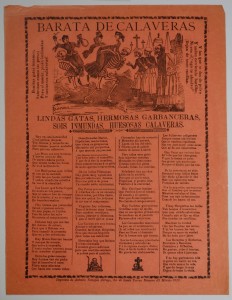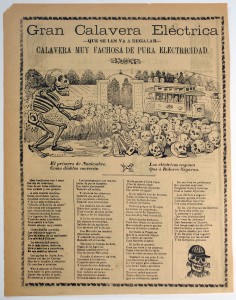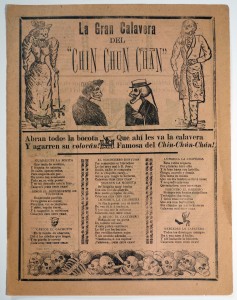Imprinting the spirit of Mexico
The international scope of the Baillieu Library Print Collection has been broadened by the acquisition of three works by José Guadalupe Posada (1852-1913). Posada is regarded by many as the founder of Mexican printmaking, bringing the medium to the masses through popular news sheets and chapbooks. He worked at the publishing house of Antonio Vanegas Arroyo, which produced thousands of periodicals and broadsides. These ephemeral printed documents communicated caricatures of contemporary individuals, news, sensational stories and issues of the day. Posada trained as a lithographer in Mexico City and promoted the use of etching on zinc and photorelief techniques to Mexico.
Barata de Calaveras (1910) depicts a skeleton carrying off two female workers. It contains the imprint of Arroyo and was printed by him for distribution during the Day of the Dead Festival. Posada is particularly renowned for his calaveras or skeletons, which his hand animated with distinctive character. Depictions of skeletons are an integral aspect of Mexican culture and many images and figurines of calaveras were produced for the annual Day of the Dead Festival.
Posada was working during the Mexican Revolution (1910-1920), a time when news sheets were an important vehicle for political messages and the shaping of an independent Mexican cultural identity. Many of Posada’s images were used across multiple sheets; they recur in varied topics and are printed under numerous titles. The image in Gran Calavera Electricia (Grand Electric Skull) (c.1910) tells, in some instances, of the calavera at the 1910 centenary celebrations for Mexican Independence Day, which recognises Mexico’s liberation from Spain. The calavera is at the cemetery gathering together the citizens who will be joining him. The beams shooting out of his eyes express his hypnotising powers on the diminutive victims. A typical commentary below the image describes the people and misadventures that culminated in the pile of skulls depicted: disreputable tortilla and pulque vendors, for example, beaten by customers including those poisoned by bad meat or liquor. Other versions reflect another frequently discussed news topic: deaths caused by electric trams. The tram car seen in the background is arriving at the cemetery to deliver its now deceased passengers. [1]
A catrina is seen at the top left of La Gran Calavera del Chin Chun Chan (c. 1910), a sheet that was a collaboration with Manuel Manilla and J. Cortes, Posada’s contemporaries working at the Arroyo publishing house. Posada made famous the catrina, or tall affluently dressed female skeleton, which has since become a symbol in Mexican art. [2] Each stanza below the image is punctuated with the title of the popular Mexican musical, ‘Chin Chun Chan’, a phrase that was also used as a substitute for swearing. Many of the broadsheets would have come to life for their audience by being spoken or sung aloud. The Baillieu Library Print Collection is delighted to add this lively Mexican voice to its holdings and thereby enhance the telling of printmaking history.
Kerrianne Stone (Curator, Prints)
[1] Posada’s Mexico edited by Ron Tyler, Washington: Library of Congress: 1979, p. 237
[2] Revolution on paper: Mexican prints 1910-1960 by Dawn Adès and Alison McClean with the assistance of Laura Campbell; edited by Mark McDonald. Published Austin [Tex.]: University of Texas Press; [London]: In co-operation with the British Museum Press, 2009, p.54
Categories
- Uncategorised
- Prints



Leave a Reply